Dark Shadows, Part 1
Shadows over Innistrad preview weeks are done, which means it's time for card-by-card design stories. I have a bunch for this set, so I'm making this a two-parter. But enough introduction. Let's move on to the stories.
Aberrant Researcher / Perfected Form
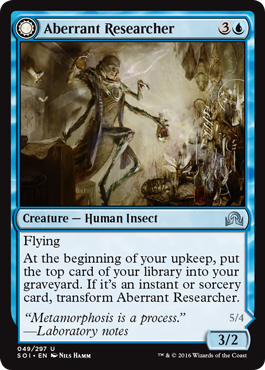
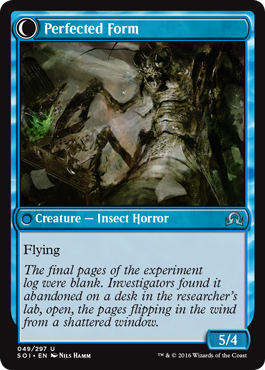
I talked in my preview articles about how we knew very early that double-faced cards were going to return. One idea that multiple people on the design team had was to try and continue a story that we told through one of the double-faced cards from original Innistrad block. We examined all the options, but the choice seemed clear. We wanted to continue the story of Delver of Secrets.
For those unaware, I was inspired to create the original Delver of Secrets to capture the trope from the movie The Fly, where a scientist messes around with technology he shouldn't and ends up becoming a monster when his body gets combined with a fly. As Magic is a fantasy game, the scientist became a Wizard and the technology became magic.
Delver of Secrets starts as a 1/1 Human Wizard, and when it transforms it turns into a 3/2 Human Insect with flying. He was messing with forces he shouldn't have, and now he has become part Human, part Insect. Shadows over Innistrad is checking back in on our Human Insect, and things aren't getting any better.
On the front side of the card—now called Aberrant Researcher but with the same stats, abilities, and creature subtypes as Insectile Aberration (the back side of Delver of Secrets)—our Wizard has not given up hope of finding a solution. But alas, things really aren't going well for him, and his experiments have gone even more wrong, now changing him from a Human Insect into an Insect Horror called Perfected Form. He's lost the remaining pieces of his humanity and has fled his lab.
Accursed Witch / Infectious Curse
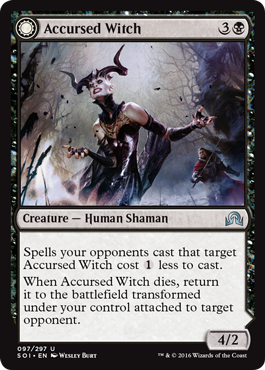
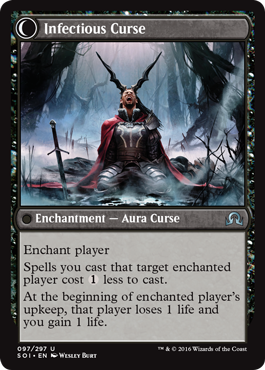
Witches play a role in horror. One of the tropes is that killing one is bad because in their death they can curse you. Innistrad played into this trope with the card Bitterheart Witch, which, when it died, allowed you to go get a Curse out of your library and enchant an opponent with it.
We were back in Innistrad, so we decided to try a new version of this trope. What if the Witch and the Curse were more closely connected? The idea was to have a Witch on one side of a double-faced card and then have the curse that results from the Witch dying on the other. From there, the next step was to find a way to mechanically tie the two sides together. The answer we came up with was to make the Witch more susceptible to dying by making any spell targeting her cost one less. Upon dying, though, she takes that curse that she held and applies it to the opponent. Now they have the very curse that the Witch once had.
Altered Ego
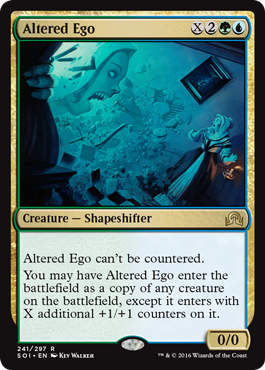
My love of both clone effects and +1/+1 counters is well known. That is why I'm sad to say that, to the best of my recollection, I didn't make this card. I have enjoyed playing it though. It's very fun to try and see what cool things you can do when the creature you copy is a bit bigger than it normally is. If I remember correctly, this card's playtest name was something like "Science Experiment."
Anguished Unmaking
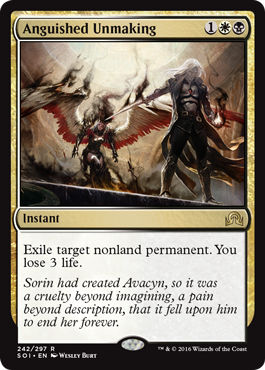
As of Battle for Zendikar, we're making a better effort to show the story in the cards. Part of doing this is ensuring that a number of the key moments of the story are shown through cards. Anguished Unmaking is one such card. In the story, it has become clear that Avacyn has gone mad and she is harming Innistrad. Jace figures out that Avacyn is the cause of the madness and has to be stopped. Unfortunately, he's no match for Avacyn. The day is saved by Sorin, who has to unmake the creation he made so many centuries ago.
This card was top-down designed from the story event we were trying to capture. I believe it was called "The Unmaking of Avacyn" in design. We made it white-black to represent that it was Sorin who was casting it. White-black (along with black-green) is one of the two-color combinations that has "remove target permanent" as a tool in its toolbox. This was tweaked to avoid it being land destruction, and an exile component was added as a defensive tool against graveyard shenanigans. The loss of life was a nice flavor touch to show how hard it was for Sorin and to allow development to make the card a bit cheaper.
Archangel Avacyn / Avacyn, the Purifier
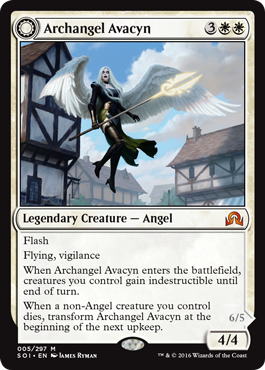
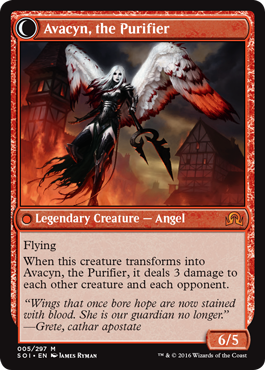
An important part of the story is that Avacyn, once the savior of Innistrad, has gone mad, and she has started harming the very people she once swore to protect. If this were a normal set, we'd probably show the mad version of Avacyn and be done with it, but we have double-faced technology, so of course we have to show her before and after the change.
The first thing we decided after talking with the story people was that Avacyn was going to start as a mono-white creature, as she was when we last saw her, and then transform into a red creature to show that she has significantly changed. The white side needed to feel much like original Avacyn, meaning she wanted to be a protector. We accomplished this by having her grant indestructible to all her creatures as an enters-the-battlefield effect. We gave her flash (something white is tertiary in) so that she could show up to surprise your opponent and save the day.
But if you lose even one creature, the madness starts to eat away at Avacyn, and she transforms into Avacyn, the Purifier. To show that she is hurting those she is supposed to help, as an effect of transforming she deals damage to all creatures (save herself) and all your opponents. We also made her a little bigger, 6/5 from 4/4, to encourage the transformation mechanically. Note, by the way, that the change isn't all for the better, as she loses vigilance. We liked that the transformation comes at a cost to what she can do. That was also very flavorful.
In design, the front side of the card was called Avacyn and the mad version on back was called Nycava—"Avacyn" backwards.
Arlinn Kord / Arlinn, Embraced by the Moon
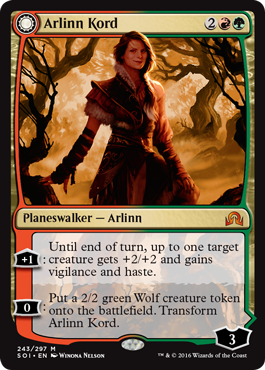
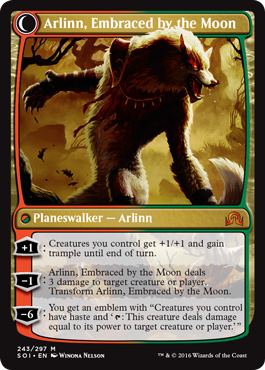
In original Innistrad design, we actually designed a Werewolf planeswalker card. It wasn't exactly this design, but it was also red and green, and it too had control of its transformation between Human and Werewolf. At the time, the creative team was interested in telling the story of Garruk's transformation and, as such, felt like that was the better place to deploy a double-faced planeswalker.
Interestingly, for Shadows over Innistrad, it was the creative team who suggested the Werewolf planeswalker. The design team was game. We had a couple things we wanted going into the design:
- It was double-faced—This one's a given, but we weren't interested in a wolfir Planeswalker.
- We wanted the transformation to be under the Planeswalker's control—We made the conscious choice not to tie Arlinn Kord to the "Werewolf" mechanic. We wanted her to have agency and felt it was important that she could change back and forth. That meant that one ability on each side had to transform her.
- We wanted her to work in a Werewolf deck—As she's a planeswalker and not a legendary creature, she wasn't going to be a commander, but we did want to make sure she was well-suited for a Werewolf deck. I have been asked by numerous people if we ever considered giving her the "This can be your commander" text, and my answer is we don't do that outside of Commander products.
With those parameters, Arlinn Kord was designed. A Wolf token component was added, which we liked. And that is how we got our Werewolf planeswalker.
Avacyn Missionaries / Lunarch Inquisitors
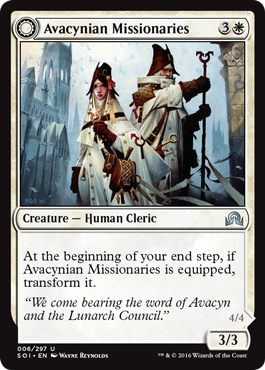
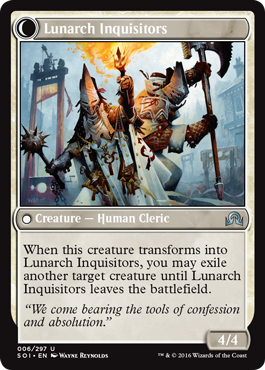
Care to take a guess what inspired this card? I'll give you a hint. It was a movie.
Click here when you have a guess.
Click to reveal
- The answer is Ghostbusters. You see, you need to equip them with their proton pack, and then they can start capturing ghosts. That is, until someone lets the ghosts back out, which would happen if the Ghostbusters were out of the picture (or some politician convinces the mayor to shut down the Ghostbusters storage facility). Innistrad, interestingly enough, is probably the plane where the greatest number of card designs got their inspiration from movies.
Bloodmad Vampire and Stensia Masquerade
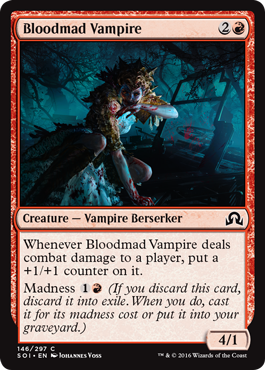
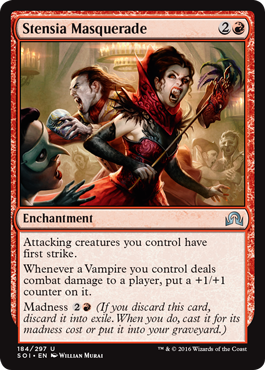
One of the big questions about doing a return is how many mechanical things you want to repeat from the first visit. The Vampires were going to stay black and red. As those were the colors that madness was in, that meant us making a change with how the Vampires were going to work as a tribe. We wanted to make a nod to how the Vampires used to be last time we were in Innistrad, so we put these two cards in as a nod to the "Slith" mechanic (getting a +1/+1 counter when it deals combat damage to a player), which was the major thing Vampires did mechanically in original Innistrad.
Bound by Moonsilver
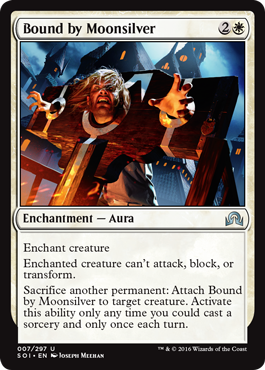
This card is a very good example of how we tweak cards to fit within a block. Pacifism and Arrest are effects we put into almost every set. In addition to stopping attacking and blocking, this card also prevents transforming. The last line wasn't added until development, when they realized white needed some more in-color ways to get cards into the graveyard. This also strengthened the card, as it let you move around which creature you were restraining.
Bygone Bishop
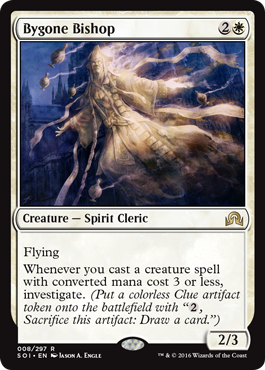
One of the questions I'm getting has to do with white having investigate. Isn't card drawing supposed to be one of white's weaknesses? It is. The reason investigate isn't a problem most of the time is the same reason that we allow white to have cantrips. White is allowed to offset the card disadvantage of casting a spell, but normally we don't let it net cards. But wait a minute, Bygone Bishop allows you to repeatedly investigate. Isn't that breaking the rules?
For a long time, we were hard and fast with the "no card drawing for white" rule. We've decided to try easing up a little, but only in a specific area. You see, the reason that white doesn't get good card drawing is that it's the color with access to all the answers; it's the one color that can deal with any type of card. To keep that from being overbearing, we don't let white have easy access to cards (red also has limited card drawing).
Recently, though, we've started playing around with the idea that white can have a little bit of card drawing when doing so requires it to be very focused in some subset of cards that represent one of white's strong suits. Bygone Bishop, as an example, requires a lot of small creatures to work, so it's harder to fill up your deck with answers when in order to make the card work, you have to have a threshold of small creatures.
Will this work out? We're not sure. That's why I've called it an experiment. We're confident enough to try putting it on actual cards, but we're going to watch to see if it causes any problems by undoing some of the safety measures put into white.
Call the Bloodline
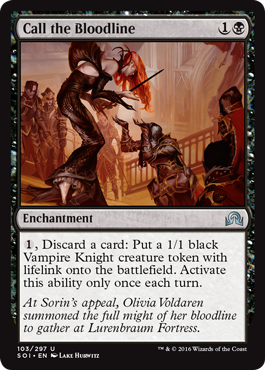
This is an interesting madness enabler. It's a repeatable effect that requires discarding. It also helps you make a Vampire-themed madness deck because it allows you to churn out Vampire tokens while enabling your madness cards, many of which are themselves Vampires.
Crawling Sensation
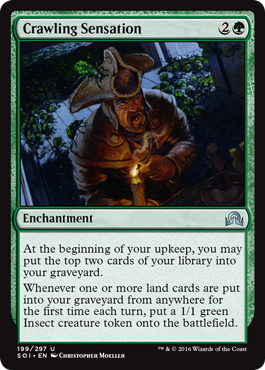
This card uses a neat design trick to self-mill (aka put cards from your library into your graveyard). Instead of making the mill the effect, you make it the random generator to see if you generate an effect. If green just milled its own cards, it would feel weird, but having it mill to see if it gets tokens feels much more green while still getting the cards into the graveyard.
Creeping Dread
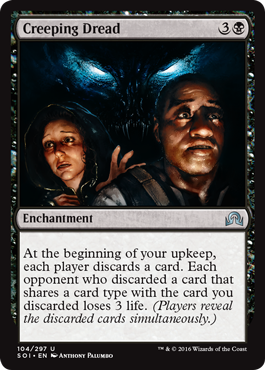
One thing that many game designers like to do but that is hard to execute is to create a game mechanic that revolves around reading other players. Bluffing is fun, so we like to create game states where players are forced to try and figure out what other players are up to, allowing players to mess with one another. This has famously blown up in our faces a number of times (Cursed Scroll, I'm looking at you.) The idea behind this card was that it was a discard enabler for things like madness, but we added in the 3 life loss rider to add in a bluffing component. This is a card I'm very curious to see what players think of.
Dance with Devils and Devils' Playground
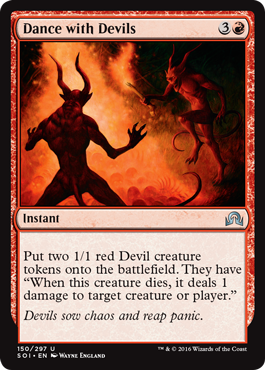
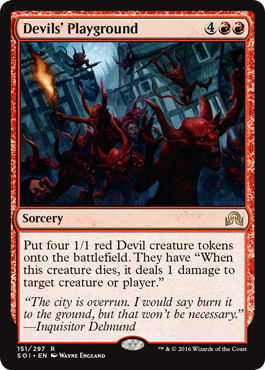
Devils' Playground was the first of these two cards to get made. I believe it originally made six Devil tokens, but that ended up being a bit too much. We reduced it down to five and then to four. Dance with Devils was made later because we liked the Devil tokens and decided we wanted to have more than one card make them.
Dauntless Cathar, Nearheath Chaplain, and Ghoulcaller's Accomplice
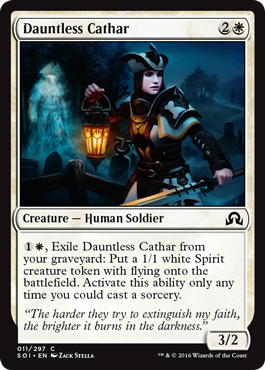
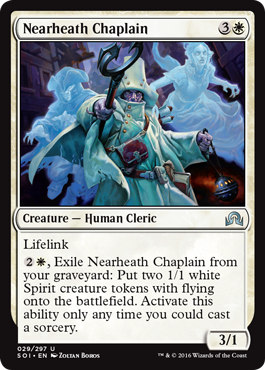

Flashback is a very fun mechanic. It was a key part of original Innstrad. The problem is that when you return to a world, you have to leave yourself some room to do new things, so we made the call to not redo flashback. The set still has a graveyard theme, though, along with some self-milling, so we wanted to find some opportunities to hit space similar to flashback.
One way to do that was to have creatures that had the ability to essentially turn into creature tokens in your graveyard. In white, you get Spirits, and in black you get Zombies. Originally, we had a bunch more of these cards. In fact, there was a section in design where this was almost a subtheme, but we realized that the set really only need a little of this, so we trimmed it down to three cards.
Declaration in Stone
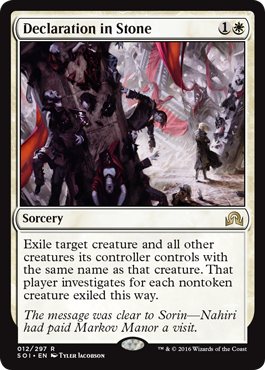
This is another card that was designed top-down to tell a moment in the story. You see, Nahiri is very mad at Sorin, so she paid a visit to his home, Markov Manor, and did some horrible things to the vampires that were there. We see Markov Manor when Jace ends up there trying to solve the mystery of Innistrad. We needed a card that conveyed both that Nahiri did this evil act and that it was something that Jace then investigated. The card couldn't be a board sweeper, as we already had a card in white that killed all the creatures. We settled on a card that kills a creature and anything that shares a name with it, allowing the controller of the creature the chance to offset the destruction. Making that payoff be a chance to investigate added a nice bit of flavor.
Elusive Tormentor / Insidious Mist
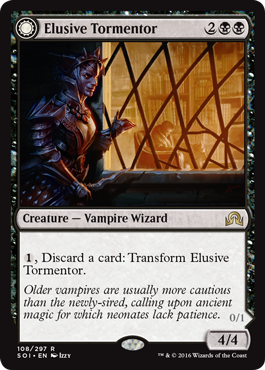
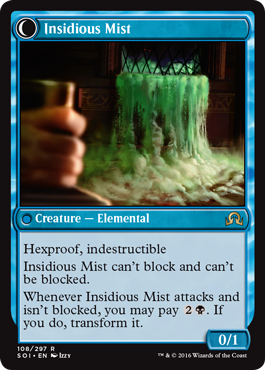
When we did double-faced cards in Innistrad block, we wrote down as many monster tropes as we could come up with, and one of them was vampires turning into mist. Another one was vampires turning into bats, and that felt like a better-known trope. That, of course, ended up becoming Screeching Bat and Stalking Vampire in original Innistrad.
When we returned, we decided we could use the "vampire into mist" trope. The trick was how best to mechanically represent it. We knew the change had to be voluntary, as the flavor is that a Vampire can freely change back and forth. We also knew we wanted to capture the flavor of mist, which is something that you can't really touch. That got us to hexproof, indestructible, and "cannot block or be blocked." We also felt that the Mist needed to be a 0/1 because it wasn't able to harm anything in that form.
We then realized that the reason the Vampire would turn into the Mist was twofold: to either save itself or become unblockable. At first the transformation required just mana, but then, as we were building madness into the Vampire tribe, we decided it would be useful to have the ability to transform into Mist require a discard. We kept the mana cost low so that you'd most often have mana left to use on a madness spell. We gave the Insidious Mist an attack trigger to allow it to turn back into a 4/4 after it was unblocked but before it dealt damage.
As Shadows Fall
That's all the time I have for today. Obviously, I only made it up to E, so that means that I'll have to finish next week. As always, I'm eager to hear any feedback on both the column and the set. You can email me or contact me through any of my social media (Twitter, Tumblr, Google+, and Instagram).
Join me next week for Part 2.
Until then, may you have fun exploring the Shadows over Innistrad.
"Drive to Work #316—Design Space"
I am often asked how we can tell how many cards we can make out of a particular mechanic. We refer to that as "design space," and in this podcast I talk all about it.
"Drive to Work #317—Lessons Learned: Theros"
This is another in my Lessons Learned series, where I examine sets I led the design for and talk about what I learned from doing them. Today, I discuss my lessons from designing Theros.
- Episode 317 Lessons Learned: Theros (15.5 MB)
- Episode 316 Design Space (19.5 MB)
- Episode 315 Collaboration (22.3 MB)
- Episode 314 Getting a Job (21.0 MB)
- Episode 313 Limited Edition, Part 6 (16.0 MB)

